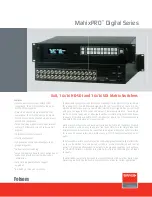
B-Series – Data Sheet
2
The B5’s highly customizable Layer 2/3/4 packet classification
capabilities work together with the 8 hardware-based priority
queues associated with each Ethernet port to support a suite of
differentiated services with as many as 8 distinct priority levels
to provide guaranteed Quality of Service (QoS) for critical voice
and video network traffic. In conjunction with its non-blocking
L2 switching and L3 routing architecture, the B5’s intelligent
queuing mechanisms ensure that mission-critical applications
receive prioritized access to network resources.
Reliability and Availability
The B5 design incorporates redundancy and failure protection
mechanisms complete with automatic failover and recovery
capabilities to provide a reliable network. An integral power
supply is the primary source of power for the B5 and complete
power redundancy is provided by an optional external power
supply. A virtual switch can be created by interconnecting as
many as eight B5s in a single stack, which can be managed via
a single IP address with redundant management connections.
The B5’s closed-loop stacking capability utilizes bi-directional
switch interconnects to maintain connectivity within the virtual
switch despite any physical failures, which includes switches,
cables and connections. Flexible Link Aggregation Groups (6
groups of 8, 12 groups of 4 or 24 groups of 2) are supported
which allow multiple Ethernet ports (8, 4 or 2) to be grouped
together to create a LAG. A LAG’s Ethernet ports can be
co-located on a single B5 or they can be distributed across
multiple B5s within a stack to prevent a switch-level failure from
disrupting data communications. The B5 also includes Host CPU
Protection support to help prevent Denial of Service (DoS) and
BPDU attacks.
Advanced Quality of Service
Robust Quality of Service (QoS) features enable strong support
for integrated multimedia networks, as well as all types of
data-intensive applications. The B5 is a standards-based
solution optimized for multimedia applications, including VoIP,
videoconferencing and real-time collaboration. The B5 uses
multiple standards-based discovery methods with Extreme
Networks policy capabilities to automatically identify and
provision VoIP services for IP phones from all major vendors. B5
switches provide dynamic mobility for VoIP clients to reduce
operating costs; when an IP phone moves and plugs in elsewhere
in the enterprise network, its VoIP service provisioning, security
and traffic priority settings move with it, with no manual
administration required.
Security
IThe B5 enables strong network security by utilizing its
authentication and security features, which can be applied at
the port level or at the user level. Making use of the Extreme
Networks Network Management Suite’s Policy Manager or a
standard CLI, the Extreme Networks role-based architecture
enables a network administrator to define distinct roles or
profiles that represent operational groups within a business
(e.g., employee, executive, guest, etc). Multiple users/devices per
port can be authenticated via IEEE 802.1X, MAC address, or web
authentication, and then assigned a pre-defined operational role.
The B5 now supports increased password security via increased
complexity, history tracking and aging. Passwords can now be
encrypted using a FIPS 1402 approved algorithm.
Administrators can easily transition from RFC 3580 and complex
access control list (ACL) deployments to the Extreme Networks
role-based policy framework in a seamless fashion, without the
need to make changes to their RADIUS infrastructure (e.g., adding
filter-ID). In addition, the B5 also supports ACLs for supplementary
network security. Network operations can be easily tailored to
meet business-oriented requirements by providing each role
with individualized access to network services and applications
(e.g., a guest should have different network access privileges
than an employee). Utilizing Extreme Networks role-based policy,
administrators are able to manipulate DSCP and 802.1p rewrite for
classification and prioritization of network traffic.
The B5 allows administrators even more network visibility, with
the ability to audit their network for adherence to compliance
regulations, such as PCI or HIPAA. The B5 is able to segment
roles down to group levels, such as supporting a guest access
role, helping to protect corporate applications and information.
Investment Protection
The B5 is a cost-effective, feature-rich, stackable switch that
provides a broad set of features today and will continue to
deliver benefits well into the future. All B-Series products include
a lifetime warranty that includes warranty and support services
for which many competitors charge additional fees – adding up
to 10% of initial deployment costs on an annual basis. Included
benefits, such as advanced hardware return, firmware feature
upgrades (which most vendors cover at most for 90 days)
and telephone support (which most don’t include or severely
limit) combine to significantly decrease operational costs for
customers over the life of their network. For more information
regarding warranty terms and conditions please go to
http://
www.ExtremeNetworks.com/support/warranty.aspx.
Performance & Scalability
The B5, with support for 32,000 MAC addresses, provides
scalable, wire-rate performance in support of the bandwidth-
intensive and delay-sensitive requirements of today’s demanding
applications. Along with a switch capacity of 184 Gbps, the
B5 provides up to 48 10/100/1000 Ethernet ports as well as
two 10 GE ports. Leveraging the B5’s stacking capability, as
many as 8 B5s (both 24-port and 48-port combinations) can
be interconnected in a single stack to create a virtual switch
that provides 1.47 Tbps of capacity and up to 384 10/100/1000
Ethernet ports as well as 16 10GE uplink ports.



























